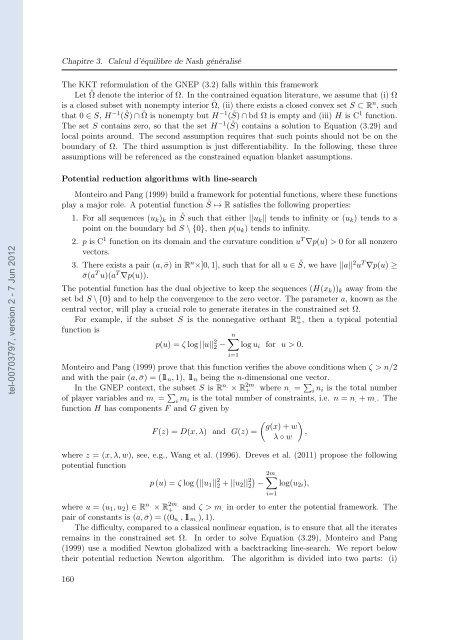Etude des marchés d'assurance non-vie à l'aide d'équilibres de ...
Etude des marchés d'assurance non-vie à l'aide d'équilibres de ...
Etude des marchés d'assurance non-vie à l'aide d'équilibres de ...
Create successful ePaper yourself
Turn your PDF publications into a flip-book with our unique Google optimized e-Paper software.
tel-00703797, version 2 - 7 Jun 2012<br />
Chapitre 3. Calcul d’équilibre <strong>de</strong> Nash généralisé<br />
The KKT reformulation of the GNEP (3.2) falls within this framework<br />
Let ˚ Ω <strong>de</strong>note the interior of Ω. In the contrained equation literature, we assume that (i) Ω<br />
is a closed subset with <strong>non</strong>empty interior ˚ Ω, (ii) there exists a closed convex set S ⊂ R n , such<br />
that 0 ∈ S, H −1 ( ˚ S) ∩ ˚ Ω is <strong>non</strong>empty but H −1 ( ˚ S) ∩ bd Ω is empty and (iii) H is C 1 function.<br />
The set S contains zero, so that the set H −1 ( ˚ S) contains a solution to Equation (3.29) and<br />
local points around. The second assumption requires that such points should not be on the<br />
boundary of Ω. The third assumption is just differentiability. In the following, these three<br />
assumptions will be referenced as the constrained equation blanket assumptions.<br />
Potential reduction algorithms with line-search<br />
Monteiro and Pang (1999) build a framework for potential functions, where these functions<br />
play a major role. A potential function ˚ S ↦→ R satisfies the following properties:<br />
1. For all sequences (uk)k in ˚ S such that either ||uk|| tends to infinity or (uk) tends to a<br />
point on the boundary bd S \ {0}, then p(uk) tends to infinity.<br />
2. p is C 1 function on its domain and the curvature condition u T ∇p(u) > 0 for all <strong>non</strong>zero<br />
vectors.<br />
3. There exists a pair (a, ¯σ) in R n ×]0, 1], such that for all u ∈ ˚ S, we have ||a|| 2 u T ∇p(u) ≥<br />
¯σ(a T u)(a T ∇p(u)).<br />
The potential function has the dual objective to keep the sequences (H(xk))k away from the<br />
set bd S \ {0} and to help the convergence to the zero vector. The parameter a, known as the<br />
central vector, will play a crucial role to generate iterates in the constrained set Ω.<br />
For example, if the subset S is the <strong>non</strong>negative orthant Rn +, then a typical potential<br />
function is<br />
p(u) = ζ log ||u|| 2 n<br />
2 − log ui for u > 0.<br />
i=1<br />
Monteiro and Pang (1999) prove that this function verifies the above conditions when ζ > n/2<br />
and with the pair (a, ¯σ) = ( 1n, 1), 1n being the n-dimensional one vector.<br />
In the GNEP context, the subset S is Rn. × R 2m.<br />
+ where n. = <br />
i ni is the total number<br />
of player variables and m. = <br />
i mi is the total number of constraints, i.e. n = n. + m.. The<br />
function H has components F and G given by<br />
<br />
g(x) + w<br />
F (z) = D(x, λ) and G(z) =<br />
,<br />
λ ◦ w<br />
where z = (x, λ, w), see, e.g., Wang et al. (1996). Dreves et al. (2011) propose the following<br />
potential function<br />
p (u) = ζ log ||u1|| 2 2 + ||u2|| 2 2m. <br />
2 − log(u2i),<br />
where u = (u1, u2) ∈ Rn. × R 2m.<br />
+ and ζ > m. in or<strong>de</strong>r to enter the potential framework. The<br />
pair of constants is (a, ¯σ) = ((0n., 1m.), 1).<br />
The difficulty, compared to a classical <strong>non</strong>linear equation, is to ensure that all the iterates<br />
remains in the constrained set Ω. In or<strong>de</strong>r to solve Equation (3.29), Monteiro and Pang<br />
(1999) use a modified Newton globalized with a backtracking line-search. We report below<br />
their potential reduction Newton algorithm. The algorithm is divi<strong>de</strong>d into two parts: (i)<br />
160<br />
i=1
















